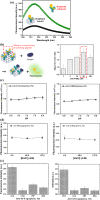One-Step Homogeneous Immunoassay for the Detection of Influenza Virus Using Switching Peptide and Graphene Quencher
- PMID: 35909466
- PMCID: PMC9326414
- DOI: 10.1007/s13206-022-00076-x
One-Step Homogeneous Immunoassay for the Detection of Influenza Virus Using Switching Peptide and Graphene Quencher
Abstract
One-step homogeneous immunoassay was developed for detecting influenza viruses A and B (Inf-A and Inf-B) using the switching peptide H2. As the fluorescence-labeled switching peptide dissociated from the binding pocket of detection antibodies, the fluorescence signal could be directly generated by the binding of Inf-A and Inf-B without washing (i.e., one-step immunoassay). For the one-step homogeneous immunoassay with detection antibodies in solution, graphene was labeled with the antibodies as a fluorescence quencher. To test the feasibility of the homogeneous one-step immunoassay, the stability of the antibody complex with the switching peptide was evaluated under different pH and salt conditions. The one-step homogeneous immunoassay with switching peptide was conducted using influenza virus antigens in phosphate-buffered saline and real samples with inactivated Inf-A and Inf-B spiked in serum. Finally, the one-step homogeneous immunoassay results were compared with those of commercially available lateral flow immunoassays.
Keywords: Influenza-A and influenza-B virus; Lateral flow immunoassay; One-step homogeneous immunoassay; Switching peptide.
© The Korean BioChip Society 2022.
Conflict of interest statement
Conflict of interestsThe authors declare that they have no known competing financial interests or personal relationships that could have appeared to influence the work reported in this paper.
Figures




Similar articles
-
Homogeneous One-Step Immunoassay Based on Switching Peptides for Detection of the Influenza Virus.Anal Chem. 2022 Jul 12;94(27):9627-9635. doi: 10.1021/acs.analchem.2c00716. Epub 2022 Jun 28. Anal Chem. 2022. PMID: 35762898
-
One-step immunoassay for the detection of food-poisoning related bacteria using a switching peptide.Analyst. 2022 Nov 21;147(23):5363-5371. doi: 10.1039/d2an00940d. Analyst. 2022. PMID: 36281825
-
An HRP-labeled lateral flow immunoassay for rapid simultaneous detection and differentiation of influenza A and B viruses.J Med Virol. 2019 Mar;91(3):503-507. doi: 10.1002/jmv.25322. Epub 2018 Oct 31. J Med Virol. 2019. PMID: 30238471
-
More reliable diagnosis of infection with human immunodeficiency virus type 1 (HIV-1) by detection of antibody IgGs to pol and gag proteins of HIV-1 and p24 antigen of HIV-1 in urine, saliva, and/or serum with highly sensitive and specific enzyme immunoassay (immune complex transfer enzyme immunoassay): a review.J Clin Lab Anal. 1997;11(5):267-86. doi: 10.1002/(SICI)1098-2825(1997)11:5<267::AID-JCLA5>3.0.CO;2-4. J Clin Lab Anal. 1997. PMID: 9292394 Free PMC article. Review.
-
Fluorescence immunoassay.Hum Pathol. 1984 Feb;15(2):112-6. doi: 10.1016/s0046-8177(84)80049-0. Hum Pathol. 1984. PMID: 6365732 Review.
Cited by
-
Monoamine Oxidase-A (MAO-A) Inhibitors Screened from the Autodisplayed Fv-Antibody Library.ACS Pharmacol Transl Sci. 2023 Dec 26;7(1):150-160. doi: 10.1021/acsptsci.3c00204. eCollection 2024 Jan 12. ACS Pharmacol Transl Sci. 2023. PMID: 38230273 Free PMC article.
References
-
- Makabe K, Nakanishi T, Tsumoto K, Tanaka Y, Kondo H, Umetsu M, Sone Y, Asano R, Kumagai I. Thermodynamic consequences of mutations in vernier zone residues of a humanized anti-human epidermal growth factor receptor murine antibody, 528. J. Biol. Chem. 2008;283:1156–1166. doi: 10.1074/jbc.M706190200. - DOI - PubMed
LinkOut - more resources
Full Text Sources
Research Materials
